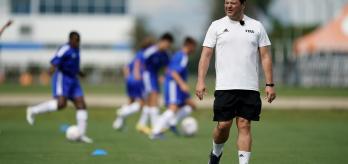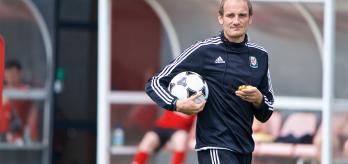Learning
-
How technical directors operate in different structures across member associations
-
The benefits of having a “panel of experts” to inform technical development matters
-
Why leadership is a function to “serve others”
Delegating the demands
National associations should consider splitting the role of technical director amongst a panel of experts to ensure each area of responsibility is managed as effectively as possible, says Mauricio Marques, FIFA Technical Leadership Expert and former Head of Coach Education at the CBF.
“I have to confess that I think when you just have one TD [technical director], it may be too much,” explains Marques “I think when it is only one TD, these guys may need some superpowers to be successful.
“Instead, I like the idea of having a panel of experts. I think it's something that we should think about as a possible new format.
“Instead of one technical director, there should be a variety of experts. You could still have one person as a reference point, but there should be experts in charge of their own areas all of whom have some autonomy. It’s a model that some associations, especially the big ones, could have.”
The panel of experts would be accountable for developing strategies that work across areas, instead of solely focusing on each area in isolation, says Marques.
“These individuals can establish the strategies in order to help the others. Then, of course, there would be regular meetings about what each area is doing and how each area can help the other. It’s thinking out of the box.”
The CBF’s C licence
How the CBF developed the content for their C licence coaching course, is an example of how multiple departments could work together to improve the game, says Marques.
“In Brazil we have a C licence that combines football, futsal and beach soccer all in the one licence. It came from talking to all the different instructors and we said ‘look it’s kids 6 to 12 years old, they just have to play. It doesn’t matter which form it is.’
“So, this more holistic approach that takes a bigger view. The idea of using an expert panel to make decisions can be compared to how we coach football: you can practise football by having technical training, stop, tactical training, stop, physical training; or you can have: football, you have the game. Everything is in the game. So, this panel would represent the game, everything together rather than in isolation.”
Structure of technical departments in South America
In South America, the majority of technical directors have different roles and responsibilities than their counterparts in Europe, explains Marques.
“In South America, the technical director is more involved with the development of specific projects,” he explains. “Because in South America you have the general secretary, then you have the head of the men’s national teams and then some countries, but not all the countries, have a head of the national women’s team. There is then a head of youth teams. The main focus for those areas is the competitiveness, they have to qualify for the World Cup.
Underneath the heads of national teams, South American associations mostly employ a director of development, or a number of heads of department, to oversee all other technical activities. It is here that Marques’s idea of a panel of experts would be used.
“Underneath the national teams you probably have one person, or a variety of people in charge of futsal, beach soccer, competitions, refereeing and so on. This is the common technical director scenario in South America.”
“Being a leader is about serving others”
Regardless of the structure of the technical department, Marques believes technical leaders are in place to “serve others” rather than be the “boss”.
“It’s interesting because when we talk about technical leadership, it sounds like we are training people to be the boss. But it’s not about that. In my view, being a leader is actually about serving others. That’s the real leader.
“So, I think for technical leaders the main focus should be on people management and being able to create a positive environment. Those are the most important skills for technical professionals to have.”
A key part of ‘serving others’ is understanding the culture and context that others work in, says Marques.
“Before starting to manage the person you should get to know the person,” he explains. “Where are they from? What do they want? What gender are they? What are their needs? What is their culture, country, religion?
“Being a good leader is about relating to people and developing connections. It’s important to help others so they can help you.”
Summary
-
In some associations, the role of technical director is split amongst a number of roles
-
Having a team of experts advising on technical matters may inform the leadership direction of technical departments in the future
-
Being a good leader is about relating to people and developing connections
Reflection
-
How would splitting the role of technical director benefit your organisation?
-
What roles would the technical director be split into?
-
How would you define the roles and responsibilities of a “good leader”?







